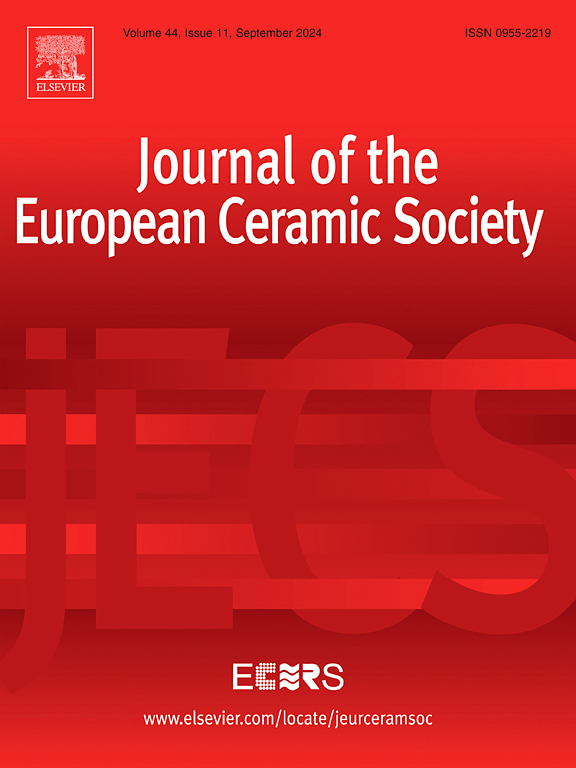Synergetic effect of oxygen vacancy and Cr triggered super-long persistent luminescence in green Ce, Cr: YAGG transparent ceramics
IF 5.8
2区 材料科学
Q1 MATERIALS SCIENCE, CERAMICS
Journal of The European Ceramic Society
Pub Date : 2025-03-12
DOI:10.1016/j.jeurceramsoc.2025.117364
引用次数: 0
Abstract
Ce, Cr: Y3Al2Ga3O12 (Ce, Cr: YAGG) as a new long afterglow material has a considerable developing potential in the fields of emergency indicator, optical information storage and bio-imaging, etc. However, short afterglow duration time and low afterglow brightness have become the key bottlenecks hindering its real applications. In this study, a high initial brightness of 6243.5 mcd/m2 and a long duration time of nearly 30 h were obtained in Ce, Cr: YAGG transparent ceramics (after being excited by a 460 nm Xe lamp for 10 min). The afterglow performances of Ce, Cr: YAGG ceramic could be significantly promoted by elevating sintering temperature, applying TEOS as sintering additive and adopting HIP sintering. More oxygen vacancies (relative amount of 32.9 %) within ceramic, compared to vacuum sintering (16.1 %), and Si induced charge compensation of Cr synergetically reinforced afterglow performance of ceramic, while ceramic transparency had a negative impact on it. A competition relationship between the “volume effect” and “light-extraction effect” was revealed in the thick and transparent afterglow medium. A new design strategy for enhancing afterglow performances of long afterglow transparent ceramics was proposed in this study.
氧空位与Cr的协同作用引发了绿色Ce, Cr: YAGG透明陶瓷的超长持续发光
Ce, Cr: Y3Al2Ga3O12 (Ce, Cr: YAGG)作为一种新型长余辉材料,在应急指示、光学信息存储和生物成像等领域具有相当大的发展潜力。然而,余辉持续时间短、余辉亮度低已成为制约其实际应用的主要瓶颈。在本研究中,Ce, Cr: YAGG透明陶瓷(在460 nm氙灯激发10 min后)获得了6243.5 mcd/m2的高初始亮度和近30 h的长持续时间。提高烧结温度、添加正硅酸乙酯(TEOS)作为烧结添加剂以及采用HIP烧结可以显著提高Ce, Cr: YAGG陶瓷的余辉性能。与真空烧结(16.1 %)相比,陶瓷内部更多的氧空位(相对量为32.9 %),Si诱导电荷补偿的Cr协同增强了陶瓷的余辉性能,而陶瓷透明度对其有负面影响。在厚而透明的余辉介质中,“体积效应”和“抽光效应”之间存在竞争关系。提出了一种提高长余辉透明陶瓷余辉性能的新设计策略。
本文章由计算机程序翻译,如有差异,请以英文原文为准。
求助全文
约1分钟内获得全文
求助全文
来源期刊

Journal of The European Ceramic Society
工程技术-材料科学:硅酸盐
CiteScore
10.70
自引率
12.30%
发文量
863
审稿时长
35 days
期刊介绍:
The Journal of the European Ceramic Society publishes the results of original research and reviews relating to ceramic materials. Papers of either an experimental or theoretical character will be welcomed on a fully international basis. The emphasis is on novel generic science concerning the relationships between processing, microstructure and properties of polycrystalline ceramics consolidated at high temperature. Papers may relate to any of the conventional categories of ceramic: structural, functional, traditional or composite. The central objective is to sustain a high standard of research quality by means of appropriate reviewing procedures.
 求助内容:
求助内容: 应助结果提醒方式:
应助结果提醒方式:


